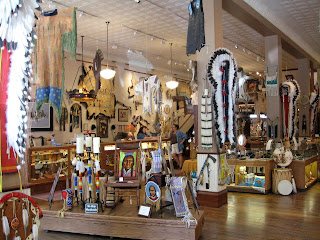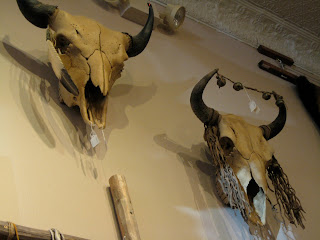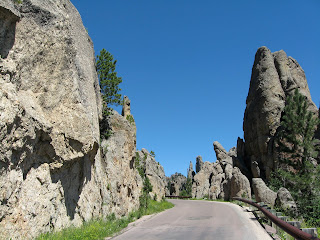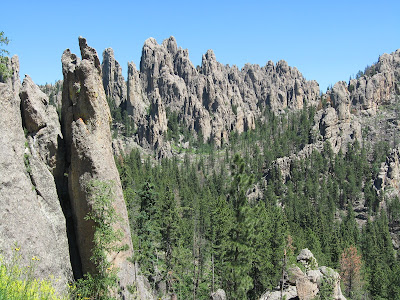I heard about Prairie Edge way before coming to Pine Ridge. It's the best and biggest store of Northern Plains Indians' art, books, music, and crafts. A lot of the art is by Indians and a lot is by non-Indians, inspired by various American Indian cultures. I didn't write down the artist for each piece, but here are bits and pieces of what you would see if you walked into this beautiful, museum-like place:
One Month on the Pine Ridge Reservation
Wednesday, July 20, 2011
Monday, July 18, 2011
A country called Pine Ridge
Pine Ridge really does feel like another country, although in different ways than I expected. There is no boundary preventing people on the reservation from entering America – people go shopping off the rez, travel to see their kids living in other parts of the country (often stationed there as part of their military service), and watch plenty of TV. People eat American food (unfortunately) and dress in American clothes. Everyone speaks English and only 10% of the population still speaks Lakota. Of course, a lot of people do not have the means to leave permanently even if they wanted to, so the boundaries of poverty certainly do exist.
But despite the permeability of the boundary marked by “Welcome to Pine Ridge” (or, on some roads, by nothing at all), there is a subtle, initially imperceptible difference in the people, and there is a visible change once one enters the reservation. The roads are narrow, one lane in each direction, and most of the side roads meandering off the paved highway are covered only in dirt. Most people don't wear seatbelts and don't have driving licenses, and the rates of motor vehicle accidents are astronomically high (almost always alcohol-related). There is land, land, land – vast and mostly untouched, with little agriculture (unlike the vast cornfields and other agricultural fields of much of Nebraska, South Dakota, Iowa, and the rest of the Midwest) – and dotted with trailers, far off along the dirt roads. In the towns, homes are clustered closer together, but generally not in neat suburban rhythms. They’re more scattered, makeshift in some undefinable way. There are gas stations and convenience stores and usually little else in most of the towns. Sometimes a health clinic. (Pine Ridge, of course, being the main exception, along with a couple of other ever so slightly big towns.)
People are mostly dark-skinned and look Indian. Many have fat around their middles (“apple-shaped”), putting them at high risk of strokes and heart attacks. Some men wear cowboy hats. Many people, men and women, have long hair. Some people are dusty and some are polished, professional-looking. Some stagger, unbalanced with alcohol. Some kids are barefoot, even in stores and other indoor public places. Some kids have plenty of toys and watch cable TV and DVDs and use computers. Many grandparents are the primary caretakers of their grandkids, with parents drunk or high or simply far away. Or passed away, from car accidents or suicide or violence.
There is a different feeling, too, on Pine Ridge. There is spirituality, and there is generosity, warmth, very close social and family ties. Spirituality and family and looking out for other people is prioritized (although of course not for everyone, especially when alcohol and drugs and abuse are present). People put lots and lots of effort into preparing for spiritual events, like sundances, sweat lodges, or memorials for those who have passed. There is a lot of humor and laid-backness. There is no rush. People are generally quite positive, and many people move forward no matter what tragedy or trouble falls next into their path. There is jealousy, too, petty or powerful and dark.
Pine Ridge does not feel commercialized. There are few commercial buildings. The souvenir shops that one would expect are absent. Perhaps, in addition to the presence of the sundances and sweats, individual spirituality, and a tenacity of tradition, Pine Ridge feels spiritual because it is not clustered with stores and bright lights and hotels and restaurants. Certainly it would be better if there was more employment and more money on the rez, but it doesn’t seem that the best way to do that would be to America-ize it, and clearly, there must be reasons why that has not happened. But maybe that’s just my sometimes anti-commercial feelings mapping themselves onto Pine Ridge. It does seem that people have a different spirit, philosophy, and attitude towards life than people outside of the reservation.
And finally, the rez is like a different country because much about the conditions is similar to those found in the third world. Not all homes have electricity, water, or sewage, though my impression is that at this point, most do have these basic amenities. Yet even if there is the physical option of heat, many don’t have the money for it in the cold winter. I am at a loss to understand how they survive. Commodity foods (free food given out by the BIA) are given on the 10th of each month, and food stamps are given out on the 1st, and they don’t always last the whole month. Perhaps that’s the point at which kids start to live off of Ramen noodles, although my impression is that sometimes that’s many kids’ main staple throughout the month – delicious, absolutely non-nutritious, and exceptionally cheap at something like a quarter per packet. Dirt roads can become impassable after rain or snow. I’m not quite sure how people get out then. Some people have cars and therefore don’t qualify for special transportation, but don’t have money for gas, and can’t get to the hospital for care. Then there is the fact that the hospital at times provides an unacceptably low level of care. In addition to the obesity and poverty, difficult access to health care leads to miserable health statistics and life expectancy that is below that found in some developing countries. There is one fire station in Pine Ridge. It is non-tribal and it is responsible only for putting out prairie fires, so when buildings burn, they can only watch and make sure that the fire doesn't spread.
Coming back from the Black Hills, I notice all of this again. I think people get used to the back and forth from the Pine Ridge world to the surrounding world, no longer jarred, but I’m a newbie and see it clearly, crystallized.
Burros and other animals of the Black Hills
We also saw burro, or descendants of non-native donkeys that hauled visitors to the top of the highest peak in the Black Hills, Harney Peak. Here they are, with ears drawn back in warning after being perhaps a little too jostled by some tourist kids:
Other animals of the Black Hills: elk, pronghorn (or antelope), deer, prairie dogs, badgers, coyotes, mountain goats, bighorn sheep, bobcats, and mountain lions!
Other animals of the Black Hills: elk, pronghorn (or antelope), deer, prairie dogs, badgers, coyotes, mountain goats, bighorn sheep, bobcats, and mountain lions!
Tatanka
I had never seen tatanka (Lakota for buffalo or, more correctly, bison) before, and I got to see them in the Black Hills' Custer State Park wildlife loop – lots of them, with a male buffalo making pretty impressive noise as the ladies and calves grazed, scratched themselves against pine trees, or fed from their mothers -- along the sides of the road or right in the middle of it. They were slightly more shabby close up than one sees in pictures, but they were big, with powerful muscles all the same. A bit like animal versions of big, furry football players.
This is the adult male bison; all the others in the photos are female or calves.
In Lakota tradition, buffalo are sacred and are considered by medicine men to be our brothers. In the past, all parts of the buffalo were used in respect for its sacrifice to keep people alive. Now, there are not many buffalo to hunt, so I’m not sure what happens.
In the mythology of the Lakota people, the White Buffalo Calf Woman figures prominently. She comes in the form of a white buffalo calf (which normally do not exist in nature) and brought the pipe to the people. She is said to return to the people in times of need. I was told that a few years ago there were several white calves born on reservations throughout the country, one nearby, either on Pine Ridge or Rosebud (another Lakota, though not Oglala Lakota, reservation just East of Pine Ridge). When they were tested for their age, their hooves tested as being several hundred years old. I like this story, even alongside my skepticism.
Here is a stained glass image of White Buffalo Calf Woman by Angela Babby, which I saw at the Red Cloud School in Pine Ridge:
Detour to the Black Hills
I had a touristy vacation weekend (hence lots of photos!) in the Black Hills with Joan Nelson, my generous host in her big, all-year house in Rushville, Nebraska, and her getaway R&R trailer in Custer, South Dakota. The Black Hills are home to Mt. Rushmore, the gold rush of the Black Hills of 1874-77, the Crazy Horse Monument (ongoing & slated to be the biggest mountain carving in the world), beautiful scenery, and a state park with a safari-type wildlife driving loop.
The elevation in the Black Hills is around 6,000 ft, higher than a mile, and the ancient mountain range used to be taller, now worn away with age to the hardest layer -- granite (which is at least part of why this site was chosen for Mt. Rushmore, to be built out of the hard granite that doesn't easily wear away). The Black Hills are unexpected -- a ribbon of mountains among flat plains and low, gently rolling hills. And they're beautiful, covered in pine, with some naked granite patches, and beautiful and expansive rock formations called the Needles and the Cathedral.
This rock is called the Needle's Eye and about two and a half of my lengths would fit into "the eye."
In a few places the road goes through wonderfully tiny tunnels.
These formations -- expansive and majestic -- are called "The Cathedral," and they really look it.
The Black Hills, or Pahá Sápa in Lakota (literally, Black Hills), are also sacred land to the Lakota, the place where the creation story tells of their beginnings. It is land that by treaty belongs to the Lakota people, settled illegally by the gold seekers in the late nineteenth century (even the U.S. army initially tried to put up a fight against the gold rushers, trying to protect Lakota land), and, through a number of equally illegal government maneuvers, was finally taken away from the Lakota people for good. Sometime in the 1980s, I think, the government finally offered $106 million to compensate for the loss of the land to the Lakota tribe, but they rejected it, insisting that the land be given back. It hasn't happened yet.
So places like Mt. Rushmore, while being a hugely important and emotional symbol of patriotism for many, is also a violation -- of the land and of American legal agreements with the Lakota. Nevertheless, we did the requisite site-seeing, and here's the photographic proof:
And this is Joan's lovely, absolutely quiet and isolated place where I got to stay while in the Black Hills:
Joan's man-made pond, with a turkey vulture hanging out on the other side.
Small meadow before the forest behind the trailer. The indentations are where deer sleep!
Another view of the deer beds.
Intertwined ponderosa pine trees.
Turkey vultures in the tree tops towards the top of the hill behind the house. They're vultures that have red heads like turkeys.
The forest deck that Joan's neighbors built. The seats fold into a table and a bed! The neighbors are quite an amazing couple -- a Methodist pastor who is also a rock and mineral expert, a funny and knowledgeable and adventurous, independent, opinionated lady; and her husband, quiet and smiling, expert builder who built by himself, in his 60s, this deck, as well as a sprawling, fancy house down the hill that serves as their home and as a spiritual and nature retreat.
The view from the deck.
The pine needles were sparkling with the late afternoon sun.
Subscribe to:
Comments (Atom)





























































